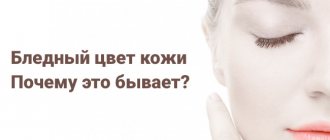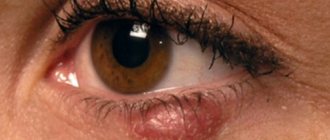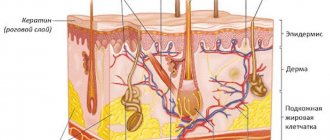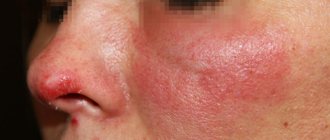Neurodermatitis (or atopic dermatitis) is a common skin disease accompanied by itching and inflammation of the skin. Among all allergic skin diseases, neurodermatitis occurs in 25-30% of cases. Atopic dermatitis occurs more often in women, and residents of large cities with unfavorable environmental conditions are also more susceptible to the disease. Poor nutrition and environmental pollution lead to an increase in the incidence of allergies throughout the world. Treatment of neurodermatitis usually requires time and the complex use of medicinal and non-medicinal methods.
Causes
Atopic dermatitis is a disease with a hereditary predisposition. The main factors in the development of the disease:
- Atopic constitutional abnormality (the body's predisposition to an excessive response when in contact with allergens).
- Features of the skin condition, weakening of its barrier function.
- Unfavorable course of pregnancy, childbirth (a factor in the development of the disease in the child).
- Irrational feeding in the first year of life (including early cessation of breastfeeding).
- Disorders of the digestive system: dysbiosis, biliary dyskinesia.
- Dysregulation of the central nervous system.
- Stress, traumatic situations.
- Overwork.
- Bad habits (smoking, alcohol abuse)1.
The risk of developing neurodermatitis in a child whose both parents suffer from allergic diseases (bronchial asthma, allergic rhinitis, urticaria) can reach 75%, so it is very important to monitor the condition of his skin from the first days of life. Various allergens provoke exacerbations of neurodermatitis:
- pet hair;
- antibacterial drugs;
- flavorings;
- plant pollen;
- house dust mites.
Atopic dermatitis is also exacerbated by upper respiratory tract infections during seasonal outbreaks of ARVI.
Diagnostics
Diagnosing neurodermatitis with a dermatologist is not difficult. This is due to the clear clinical picture. Initially, anamnesis is collected. During a conversation with a patient, the doctor is primarily interested in the presence of atopic diseases in relatives. He will also be interested in other questions in particular:
- Seasonality of exacerbations of pathology.
- Negative reactions to vaccination.
- Presence of allergic reactions.
A general blood test is important for making a diagnosis. First of all, the level of eosinophils and leukocytes, as well as ESR indicators, are assessed. Additionally, skin tests and cultures are performed. An immunogram is also performed, which allows you to evaluate the main indicators of the immune system. During diagnosis, other studies may be prescribed to rule out scabies, psoriasis, eczema and other diseases with similar symptoms.
To diagnose the presence of concomitant chronic diseases, consultations with highly specialized specialists are required. Based on their recommendations, the required laboratory and instrumental studies are carried out. Patients must undergo a psychological examination. This allows you to confirm or exclude the presence of malfunctions in the autonomic nervous system.
Symptoms
Neurodermatitis can occur acutely, subacutely or chronically with exacerbations3. There are several criteria to recognize the disease:
- A variety of skin rashes. There is redness of the skin, the appearance of spots of various shapes, scales, crusts, areas of thickening of the skin, increased skin pattern, roughness, and pigmentation disorders. The severity and type of elements of the rash depend on the form and severity of the disease3.
- Symmetrical rashes. Most often, rashes occur on the skin of the face, head, neck, shoulders, legs, elbows and popliteal fossae. The rash may be widespread or localized.
- Long-term course with periodic exacerbations. Onset usually occurs in childhood or early adolescence. The disease occurs with periods of remissions and exacerbations.
- Changes in the nature of the rash with age. As you get older, the rashes change their location. Inflammatory elements give way to areas of dryness and thickening of the skin.
- Severe itching. The itching is debilitating, worsens at night, and leads to sleep disturbances.
- The addition of a secondary infection of the skin occurs due to scratching of the rash.
- Paleness, dry skin, dull hair, flaking on the eyelids (the so-called “atopic face”).
- The presence of other diseases of allergic origin (asthma, seasonal rhinitis).
The manifestations of neurodermatitis change with age. During infancy, the course of the disease is acute, there is redness of the skin, swelling, exudation with subsequent formation of crusts. From the third year of life, neurodermatitis in children occurs in a chronic form with symptoms of dryness and thickening of the skin2. Characterized by redness of the skin, the presence of itchy papules, areas of peeling, and pigmentation disorders. In severe cases, it may be accompanied by a bacterial infection with the appearance of pustules, increased body temperature and general intoxication of the body. Atopic cataracts and visual impairment are a rare complication of severe atopic dermatitis, occurring in approximately 1% of patients.
Symptoms
Symptoms of neuroderma are an itchy rash on the skin. When scratching the skin, there is a risk of violating its integrity. Because of this, there are risks of bacterial penetration and the development of inflammation. In such cases, it is necessary to use antiseptic drugs, which can now be purchased in pharmacies or ordered online with delivery to the specified address.
The pathology can affect small areas of the skin, but in severe cases, large areas of damage are observed. If they occur in several places, then widespread atopic dermatitis is diagnosed. On the skin, when neurodermatitis develops, photos confirm this; plaques first appear, which consist of small papules. Additionally, there is a feeling of increased dryness, and visually it seems that the skin is sprinkled with flour.
Since the skin rash is constantly itchy, scratch marks may appear over time. This can be avoided if you use special medications. Today they are often sold in pharmacies on promotions, so they are cheap.
Treatment
Since neurodermatitis is a chronic disease, it requires long-term complex treatment. Main directions of therapy:
- Limiting contact with allergens. It is important to follow a diet that excludes food allergens. These most often include citrus fruits, coffee, eggs, smoked foods, products containing dyes and flavors. In residential areas, you need to get rid of fungal mold and dust mites.
- Correction of underlying diseases. Since the development of neurodermatitis is influenced by the state of the central nervous system and gastrointestinal tract, it is necessary to ensure their normal functioning. You should avoid stress, follow a sleep and rest schedule, and maintain a balanced diet. If necessary, use enzyme preparations and prokinetics.
- Drug treatment. Use sedatives and antihistamines, emollients, vitamins, glucocorticosteroids (for sudden, severe exacerbations under the supervision of a physician). For local treatment of inflamed skin, moisturizing, antipruritic ointments and gels are used. They often contain components such as menthol, anesthesin and tar. For bacterial skin infections, antibiotic ointments are prescribed1.
Physiotherapeutic procedures – phototherapy, laser therapy, plasmapheresis – can be used in complex treatment.
Cetrin for neurodermatitis
Cetrin is a second generation antihistamine used for acute and chronic allergic diseases. The active substance, cetirizine hydrochloride, blocks H1-histamine receptors4. This prevents the development of allergic reactions, which result in redness, swelling of the skin, and severe itching.
Advantages of the drug:
- Practically does not cause drowsiness in a therapeutic dosage.
- Take 1 tablet (10 mg) 1 time per day, regardless of food intake.
- Begins to act 20 minutes after administration.
- The effect lasts up to 3 days after the last dose of the drug.
- Suitable for use in children over 6 years of age4.
Cetrin is suitable for the treatment of exacerbations of neurodermatitis in adults and children. It relieves itching, the severity of skin hyperemia, and improves the quality of life of people suffering from atopic dermatitis1.
Atopic dermatitis (neurodermatitis)
Atopic dermatitis is a chronic disease that develops in individuals with a genetic predisposition to atopy. Clinically, this is manifested by the characteristic location of skin lesions, their intense itching and the development of secondary changes on the skin due to scratching. The childhood form of atopic dermatitis is often called childhood eczema; the disease in adults is usually called neurodermatitis. Symptoms and course:
In the vast majority of cases (about 90%), the first symptoms of this disease are observed before the age of five, and more than half of those affected are infants. The main symptom of atopic dermatitis for any type of rash is severe skin itching. Skin lesions can be focal or diffuse in nature.
There are three main stages of the disease: infant (up to two years), childhood (2-12 years), adult (over 12 years). The rashes during these periods are different: for example, before the age of two, they usually have the form of bubbles (vesicles), which can merge into weeping areas, then forming crusts. They are located mainly on the arms, legs and face, and by the age of two they are concentrated in the folds of the limbs, on the neck and wrists. From the age of two years, atopic dermatitis often manifests itself as peeling and irritation, as well as cracking of the skin. The lesions have defined boundaries, the skin pattern on them is clearly defined. A characteristic sign of the disease is the presence of hyperpigmentation on the skin after the rash disappears.
In adulthood, in the absence of adequate treatment, rashes can cover almost the entire upper body, forming large lesions. The chronic form of the disease is also characterized by hyperemia of the soles (the so-called 'winter foot'), accompanied by cracks and peeling, partial hair loss on the back of the head, and the formation of folds on the lower eyelid ('Morgan syndrome').
During the period between exacerbations, the disease may manifest itself only as small, flaky pink spots and barely noticeable cracks in the area of the earlobes.
The disease tends to worsen, especially in young children. In them it develops most often against the background of exudative diathesis associated with a congenital anomaly. An important role is played by intrauterine sensitization of the fetus due to the monotonous diet of a pregnant woman with the daily consumption of a large number of allergen foods.
It has been established that the most common are: cow's milk (up to 2-3 liters per day), chicken eggs, fish, cereals (especially wheat, oats, buckwheat), vegetables (tomatoes), fruits and berries (citrus fruits, grapes, strawberries, nuts). The predisposition to allergic diseases of the unborn child's body is influenced by the unfavorable course of pregnancy - toxicosis, infectious diseases, nervous experiences and stress, and irrational regimen. The development of skin manifestations in infants is often affected by the early introduction of complementary foods and artificial feeding.
In older children, allergens can penetrate not only through the gastrointestinal tract, but also through the respiratory tract and skin. These are environmental substances - room dust, pollen of various plants and flowers, wool, smells of perfumes, paints, etc. With age, the manifestations of the disease usually decrease.
By the age of 3-5 years, most children recover, but in about a third, eczema turns into neurodermatitis. The amount of fatty acids and wax in the epidermis is significantly reduced, and sweating is reduced. The skin acquires a yellowish-gray color, becomes dry, rough, and often flakes, and the hair becomes thin and dull.
An important role in the manifestation of neurodermatitis in adults is played by disturbances in the functional state of various parts of the nervous system. The duration of the disease is estimated in decades.
There are two forms of neurodermatitis. With limited neutrodermatitis, the process is localized mainly on the neck, in the popliteal dimples, elbow bends, and inguinal-femoral folds. With diffuse neurodermatitis, any areas of the skin can be involved in the process. The affected surface is covered with scales, blood crusts and cracks. Both forms are characterized by skin-colored nodules that tend to merge and form a continuous infiltration. And also a sharp, sometimes unbearable itching with scratching, often leaving small scars.
Quite often, neurodermatitis is complicated by pyococcal infection, often in the form of various streptostaphyloderma. In children, the most severe complication is possible - Kaposi's eczema herpetiformis, which occurs as a result of infection with the herpes simplex virus.
Treatment:
The disease resolves on its own in dry, hot climates (Central Asia, Crimea). Normalization of the regimen, rest, diet therapy, elimination of allergens and treatment of concomitant diseases are important. It is recommended to prescribe general medications (antihistamines, desensitizers, pyrogenic drugs, stimulants, vitamin therapy), physiotherapeutic methods, etc. External corticosteroid and tar ointments.
An important direction in the treatment of atopic dermatitis is the creation of an optimal psycho-emotional environment. It must be taken into account that emotional stress can provoke itching.
Diet
First of all, you need to exclude:
meat and fish broths, fried meat, chocolate, cocoa, citrus fruits (lemons, tangerines, oranges, grapefruits), strawberries, black currants, melon, honey, pomegranates, nuts, mushrooms, fish roe, spices, smoked meats, canned and other products, containing added preservatives and dyes.
It is advisable to add vegetable oil (sunflower, olive, etc.) to the diet up to 30 g per day in the form of salad dressings. Vitamin F-99 is prescribed, containing a combination of linoleic and linolenic acids - in high doses (4 capsules 2 times a day), or in medium doses (1-2 capsules 2 times a day). The drug is especially effective in adults.
Drug treatment
It is carried out strictly individually and may include tranquilizers, antiallergic, anti-inflammatory and detoxification agents.
It should be noted that a large number of methods and means have been proposed for atopic dermatitis (hormones, cytostatics, intal, allergoglobulin, specific hyposensitization, PUVA therapy, plasmapheresis, acupuncture, fasting-dietary therapy, etc.). However, the most important in practice are medications that have an antipruritic effect - antihistamines and tranquilizers.
Antihistamines are prescribed to relieve itching and swelling in skin manifestations, as well as in atopic syndrome (asthma, rhinitis).
When using first-generation antihistamines (suprastin, tavegil, diazolin, fercarol) daily, you must remember that they become quickly addictive. Therefore, these drugs should be changed every 5-7 days. Penetrating through the blood into the brain tissue, first-generation drugs cause a calming effect, so they should not be prescribed to students, drivers and anyone who must lead an active lifestyle, as concentration is reduced and coordination of movements is impaired.
Second generation drugs - loratodine (Claritin), astemizole, ebostin, cetirizine, fexofenadine.
Hormones are used to a limited extent and for common processes, as well as unbearable, painful itching that cannot be eliminated by other means. Hormones (preferably metypred or triamcinolone) are given for several days to relieve the severity of the attack with a gradual reduction in the dose.
If the process and phenomena of intoxication are widespread, intensive therapy is used using intravenous agents (hemodez, rheopolyglucin, polyion solution, saline solution, etc.). Hemosorption and plasmapheresis (special methods of blood purification) have proven themselves well.
Light therapy can be a very useful adjuvant in the treatment of persistent atopic dermatitis. Ultraviolet light requires only 3-4 treatments per week and has few side effects.
When an infection occurs, broad-spectrum antibiotics are used. Erythromycin, Rondomycin, Vibramycin are prescribed for 6-7 days. In childhood, tetracycline drugs (tetracycline, doxycycline) are prescribed from the age of 9 years. A complication of herpetic infection is an indication for the use of acyclovir or famvir in age-specific dosages.
In the treatment of complicated forms of atopic dermatitis, it is necessary to include, especially in children, enzyme preparations (Abomin, Festal, Mezim-Forte, Panzinorm) and various eubiotics (Bifidumbacterin, Bactisubtil, Linex, etc.). It is better to prescribe eubiotics based on the results of a microbiological study of stool for dysbacteriosis.
The administration of antioxidants, especially aevit and vetoron, also has a good effect.
External treatment is carried out taking into account the severity of the inflammatory reaction, the extent of the lesion, age and concomitant complications of local infection.
In the acute stage, accompanied by weeping and crusting, lotions containing anti-inflammatory, disinfectant drugs (for example, Burov's liquid, chamomile infusion, tea) are used. After the symptoms of acute inflammation have been relieved, creams, ointments and pastes containing soothing and anti-inflammatory substances (naftalan oil 2-10%, tar 1-2%, ichthyol 2-5%, sulfur, etc.) are used.
Hormonal drugs are widely used in external therapy. Among them are celestoderm (cream, ointment), celestoderm with garamycin and triderm (cream, ointment), elokom (cream, ointment) and advantan.
Prevention:
If the expectant mother has allergic diseases, then during pregnancy it is necessary to follow a diet and limit the use of medications, especially intravenous glucose infusions. The nursing mother should be on a strict diet with the exclusion of food allergens, and the child should receive proper hygienic care (bathe only with baby soap, avoid washing clothes with synthetic powders, avoid wrapping, etc.).
An individual approach to preventive vaccinations, administration of blood products and certain medications that contribute to further allergization of the patient is required.







